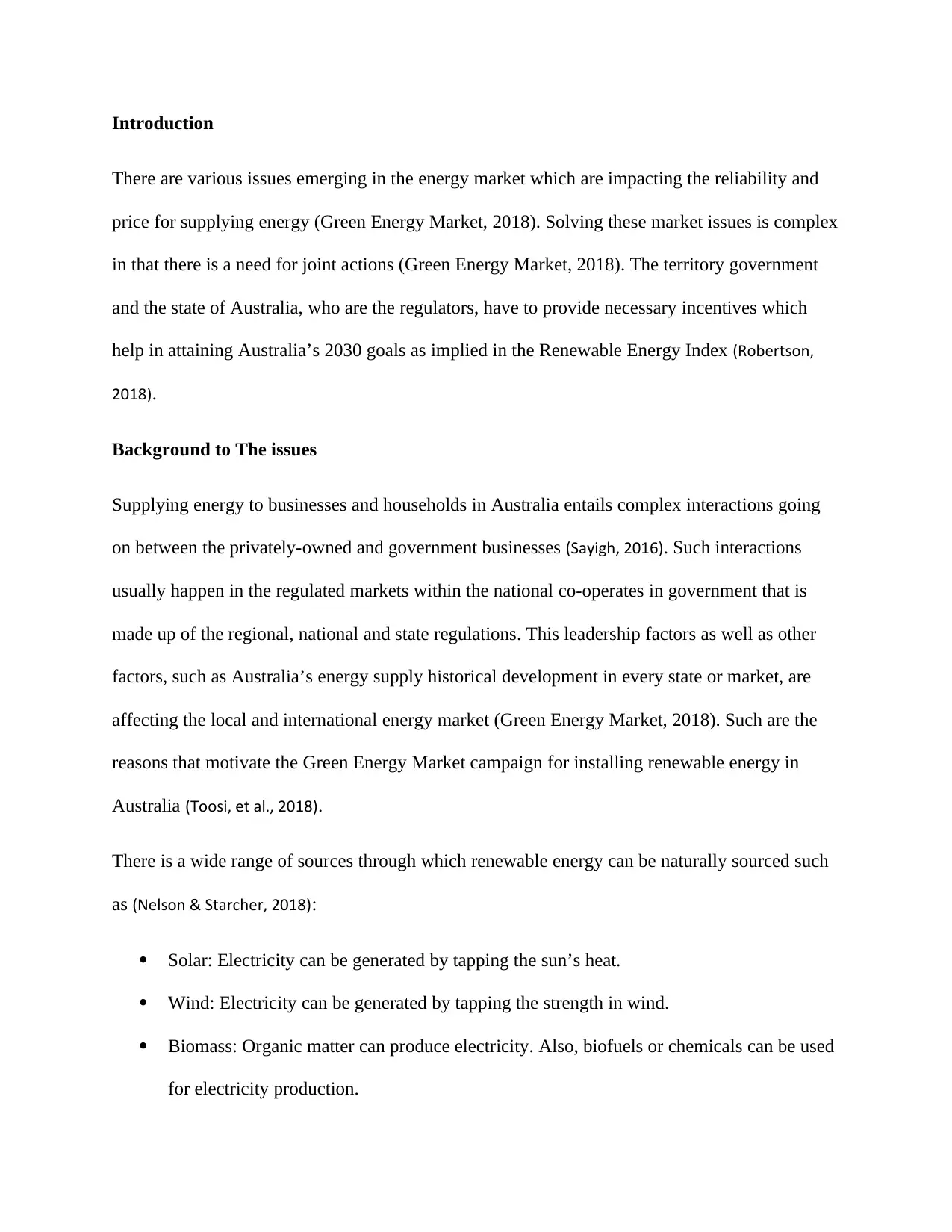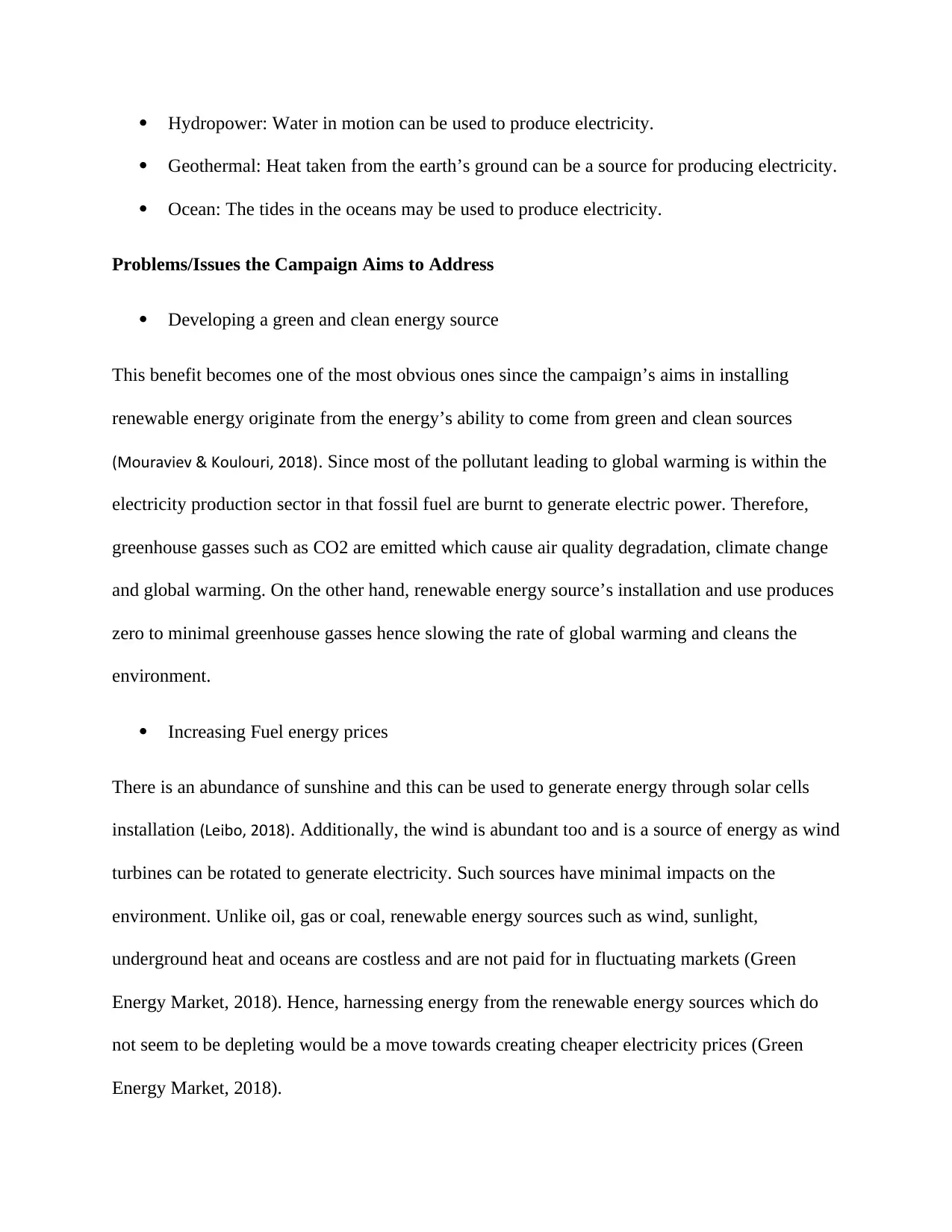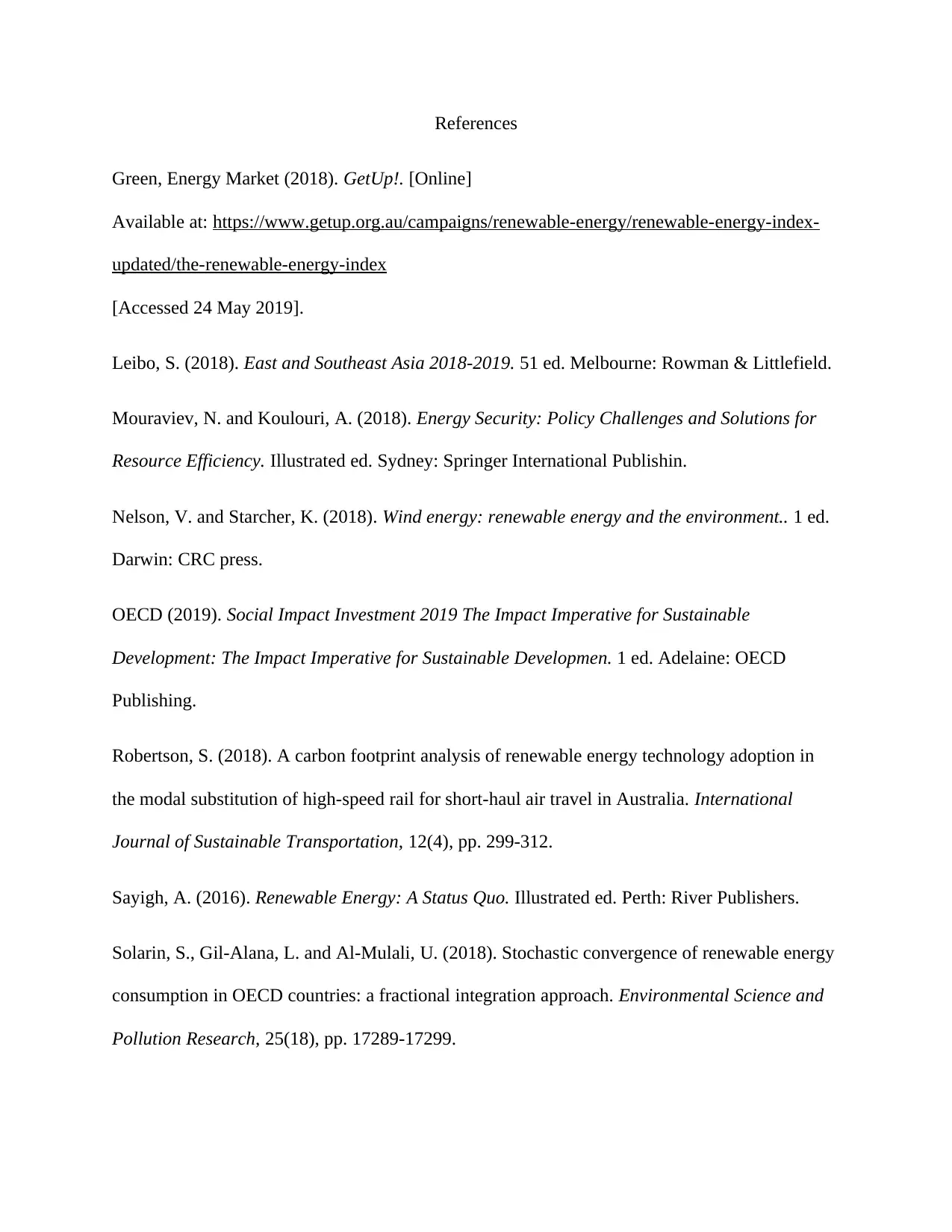Sustainability and Renewable Energy in Australia
VerifiedAdded on 2023/03/31
|8
|1345
|109
AI Summary
This article discusses the issues and goals of the Green Energy Market campaign for installing renewable energy in Australia. It explores the benefits of renewable energy, such as reducing greenhouse gas emissions and creating job opportunities. The article also addresses challenges in the energy market and potential solutions for achieving sustainability.
Contribute Materials
Your contribution can guide someone’s learning journey. Share your
documents today.

SUSTAINABILITY
By (Student’s Name)
Tutor’s Name
University
Course
City
Date
By (Student’s Name)
Tutor’s Name
University
Course
City
Date
Secure Best Marks with AI Grader
Need help grading? Try our AI Grader for instant feedback on your assignments.

Introduction
There are various issues emerging in the energy market which are impacting the reliability and
price for supplying energy (Green Energy Market, 2018). Solving these market issues is complex
in that there is a need for joint actions (Green Energy Market, 2018). The territory government
and the state of Australia, who are the regulators, have to provide necessary incentives which
help in attaining Australia’s 2030 goals as implied in the Renewable Energy Index (Robertson,
2018).
Background to The issues
Supplying energy to businesses and households in Australia entails complex interactions going
on between the privately-owned and government businesses (Sayigh, 2016). Such interactions
usually happen in the regulated markets within the national co-operates in government that is
made up of the regional, national and state regulations. This leadership factors as well as other
factors, such as Australia’s energy supply historical development in every state or market, are
affecting the local and international energy market (Green Energy Market, 2018). Such are the
reasons that motivate the Green Energy Market campaign for installing renewable energy in
Australia (Toosi, et al., 2018).
There is a wide range of sources through which renewable energy can be naturally sourced such
as (Nelson & Starcher, 2018):
Solar: Electricity can be generated by tapping the sun’s heat.
Wind: Electricity can be generated by tapping the strength in wind.
Biomass: Organic matter can produce electricity. Also, biofuels or chemicals can be used
for electricity production.
There are various issues emerging in the energy market which are impacting the reliability and
price for supplying energy (Green Energy Market, 2018). Solving these market issues is complex
in that there is a need for joint actions (Green Energy Market, 2018). The territory government
and the state of Australia, who are the regulators, have to provide necessary incentives which
help in attaining Australia’s 2030 goals as implied in the Renewable Energy Index (Robertson,
2018).
Background to The issues
Supplying energy to businesses and households in Australia entails complex interactions going
on between the privately-owned and government businesses (Sayigh, 2016). Such interactions
usually happen in the regulated markets within the national co-operates in government that is
made up of the regional, national and state regulations. This leadership factors as well as other
factors, such as Australia’s energy supply historical development in every state or market, are
affecting the local and international energy market (Green Energy Market, 2018). Such are the
reasons that motivate the Green Energy Market campaign for installing renewable energy in
Australia (Toosi, et al., 2018).
There is a wide range of sources through which renewable energy can be naturally sourced such
as (Nelson & Starcher, 2018):
Solar: Electricity can be generated by tapping the sun’s heat.
Wind: Electricity can be generated by tapping the strength in wind.
Biomass: Organic matter can produce electricity. Also, biofuels or chemicals can be used
for electricity production.

Hydropower: Water in motion can be used to produce electricity.
Geothermal: Heat taken from the earth’s ground can be a source for producing electricity.
Ocean: The tides in the oceans may be used to produce electricity.
Problems/Issues the Campaign Aims to Address
Developing a green and clean energy source
This benefit becomes one of the most obvious ones since the campaign’s aims in installing
renewable energy originate from the energy’s ability to come from green and clean sources
(Mouraviev & Koulouri, 2018). Since most of the pollutant leading to global warming is within the
electricity production sector in that fossil fuel are burnt to generate electric power. Therefore,
greenhouse gasses such as CO2 are emitted which cause air quality degradation, climate change
and global warming. On the other hand, renewable energy source’s installation and use produces
zero to minimal greenhouse gasses hence slowing the rate of global warming and cleans the
environment.
Increasing Fuel energy prices
There is an abundance of sunshine and this can be used to generate energy through solar cells
installation (Leibo, 2018). Additionally, the wind is abundant too and is a source of energy as wind
turbines can be rotated to generate electricity. Such sources have minimal impacts on the
environment. Unlike oil, gas or coal, renewable energy sources such as wind, sunlight,
underground heat and oceans are costless and are not paid for in fluctuating markets (Green
Energy Market, 2018). Hence, harnessing energy from the renewable energy sources which do
not seem to be depleting would be a move towards creating cheaper electricity prices (Green
Energy Market, 2018).
Geothermal: Heat taken from the earth’s ground can be a source for producing electricity.
Ocean: The tides in the oceans may be used to produce electricity.
Problems/Issues the Campaign Aims to Address
Developing a green and clean energy source
This benefit becomes one of the most obvious ones since the campaign’s aims in installing
renewable energy originate from the energy’s ability to come from green and clean sources
(Mouraviev & Koulouri, 2018). Since most of the pollutant leading to global warming is within the
electricity production sector in that fossil fuel are burnt to generate electric power. Therefore,
greenhouse gasses such as CO2 are emitted which cause air quality degradation, climate change
and global warming. On the other hand, renewable energy source’s installation and use produces
zero to minimal greenhouse gasses hence slowing the rate of global warming and cleans the
environment.
Increasing Fuel energy prices
There is an abundance of sunshine and this can be used to generate energy through solar cells
installation (Leibo, 2018). Additionally, the wind is abundant too and is a source of energy as wind
turbines can be rotated to generate electricity. Such sources have minimal impacts on the
environment. Unlike oil, gas or coal, renewable energy sources such as wind, sunlight,
underground heat and oceans are costless and are not paid for in fluctuating markets (Green
Energy Market, 2018). Hence, harnessing energy from the renewable energy sources which do
not seem to be depleting would be a move towards creating cheaper electricity prices (Green
Energy Market, 2018).

Tight grid energy dependent housing
Stored energy and renewable energy that self generate is a solution that may solve dependency of
household energy to power grids which mostly burn fuel to produce energy (Solarin, et al., 2018).
When one installs solar panels on the house-hold and integrate sit to the power grid, there is an
automatic reduction in reliance to the grid’s electricity (Mouraviev & Koulouri, 2018). Moreover,
buying batteries to store energy adds to the dependency since excess electricity from the solar
could be stored for later use.
Reduced job creation
There is a high potential for renewable energy to increase opportunities for employment and help
in developing the economy (OECD, 2019). an expected population of workers that can work in
renewable energy across the world is about 24 million when 2030 reaches. Such kind of growth
is included in Australia’s economy which is able to increase to 17%. This percentage takes up
the percentage drop expected in coal exports (Sayigh, 2016).
Defining the campaign Goals/Objectives
Job creation
Australia’s green energy is expected to include large-scale projects. These projects are aimed to
provide about 24,000 jobs in a year within the solar installation duration (Green Energy Market,
2018).
Rooftop solar installation
The campaign is targeting to install numerous rooftop solar panels. At the moment, the last
year’s total number of solar installation has already been surpassed (Green Energy Market,
Stored energy and renewable energy that self generate is a solution that may solve dependency of
household energy to power grids which mostly burn fuel to produce energy (Solarin, et al., 2018).
When one installs solar panels on the house-hold and integrate sit to the power grid, there is an
automatic reduction in reliance to the grid’s electricity (Mouraviev & Koulouri, 2018). Moreover,
buying batteries to store energy adds to the dependency since excess electricity from the solar
could be stored for later use.
Reduced job creation
There is a high potential for renewable energy to increase opportunities for employment and help
in developing the economy (OECD, 2019). an expected population of workers that can work in
renewable energy across the world is about 24 million when 2030 reaches. Such kind of growth
is included in Australia’s economy which is able to increase to 17%. This percentage takes up
the percentage drop expected in coal exports (Sayigh, 2016).
Defining the campaign Goals/Objectives
Job creation
Australia’s green energy is expected to include large-scale projects. These projects are aimed to
provide about 24,000 jobs in a year within the solar installation duration (Green Energy Market,
2018).
Rooftop solar installation
The campaign is targeting to install numerous rooftop solar panels. At the moment, the last
year’s total number of solar installation has already been surpassed (Green Energy Market,
Secure Best Marks with AI Grader
Need help grading? Try our AI Grader for instant feedback on your assignments.

2018). The nation stands at 1243MW which is more than the big Liddell power station that uses
coal to produce energy. Looking at the year’s installed solar panel capacity, it is foreseen that the
in 2018’s work would have surpassed the Hazelwood power station’s capacity (Green Energy
Market, 2018). This is the progress that the campaign intends to accomplish.
Engaging in large-scale projects
Looking at the large-scale projects that the campaign is involved in, there is an assurance that the
solar and wind farms that generate 412MW indicate the commission (Green Energy Market,
2018). Also, there is an overall 3,200 MW power generation from the installed renewable energy
sources (Green Energy Market, 2018). This is the tempo the Green Energy market campaign
wants to maintain and later be able to represent about 78% energy generation from clean energy.
The east and west Australian coast will be the main source of all this energy (Green Energy
Market, 2018).
How did the campaign establish credibility as activists?
The future of Australia’s renewable energy has crucial importance to national choices. The
nation could either choose to implement the reactive path whereby renewable energy sources
would be avoided since they have known costs in their economy as well as issues in power
quality (Green Energy Market, 2018). On the other hand, the nation may opt to be proactive and
activate the adoption of renewable energy systems. The adoption of renewable energy is now
seen to be a better option since the campaigns push for job creation as well as a stimulating
business opportunity in exporting energy as wee=ll as the following benefits (Green Energy
Market, 2018);
Installation of 21,173 solar systems in one month for power generation.
coal to produce energy. Looking at the year’s installed solar panel capacity, it is foreseen that the
in 2018’s work would have surpassed the Hazelwood power station’s capacity (Green Energy
Market, 2018). This is the progress that the campaign intends to accomplish.
Engaging in large-scale projects
Looking at the large-scale projects that the campaign is involved in, there is an assurance that the
solar and wind farms that generate 412MW indicate the commission (Green Energy Market,
2018). Also, there is an overall 3,200 MW power generation from the installed renewable energy
sources (Green Energy Market, 2018). This is the tempo the Green Energy market campaign
wants to maintain and later be able to represent about 78% energy generation from clean energy.
The east and west Australian coast will be the main source of all this energy (Green Energy
Market, 2018).
How did the campaign establish credibility as activists?
The future of Australia’s renewable energy has crucial importance to national choices. The
nation could either choose to implement the reactive path whereby renewable energy sources
would be avoided since they have known costs in their economy as well as issues in power
quality (Green Energy Market, 2018). On the other hand, the nation may opt to be proactive and
activate the adoption of renewable energy systems. The adoption of renewable energy is now
seen to be a better option since the campaigns push for job creation as well as a stimulating
business opportunity in exporting energy as wee=ll as the following benefits (Green Energy
Market, 2018);
Installation of 21,173 solar systems in one month for power generation.

Generation of 6,778 MW of energy from renewable sources.
Generating about 22.5% of main grid electricity for Australia.
These listed achievements make up the reasons for establishing the campaign as activists.
Conclusion
There are personal benefits such as home energy independence obtained from installing sources
of renewable energy on households. Broader benefits to the community such as reduced energy
prices have also came from the clean energy campaign (Green Energy Market, 2018). Lastly, it is
clear that the renewable energy index has projects that are putting Australia on the track to
having its entire electricity entirely generated from green and clean sources by 2030 (Green
Energy Market, 2018).
Generating about 22.5% of main grid electricity for Australia.
These listed achievements make up the reasons for establishing the campaign as activists.
Conclusion
There are personal benefits such as home energy independence obtained from installing sources
of renewable energy on households. Broader benefits to the community such as reduced energy
prices have also came from the clean energy campaign (Green Energy Market, 2018). Lastly, it is
clear that the renewable energy index has projects that are putting Australia on the track to
having its entire electricity entirely generated from green and clean sources by 2030 (Green
Energy Market, 2018).

References
Green, Energy Market (2018). GetUp!. [Online]
Available at: https://www.getup.org.au/campaigns/renewable-energy/renewable-energy-index-
updated/the-renewable-energy-index
[Accessed 24 May 2019].
Leibo, S. (2018). East and Southeast Asia 2018-2019. 51 ed. Melbourne: Rowman & Littlefield.
Mouraviev, N. and Koulouri, A. (2018). Energy Security: Policy Challenges and Solutions for
Resource Efficiency. Illustrated ed. Sydney: Springer International Publishin.
Nelson, V. and Starcher, K. (2018). Wind energy: renewable energy and the environment.. 1 ed.
Darwin: CRC press.
OECD (2019). Social Impact Investment 2019 The Impact Imperative for Sustainable
Development: The Impact Imperative for Sustainable Developmen. 1 ed. Adelaine: OECD
Publishing.
Robertson, S. (2018). A carbon footprint analysis of renewable energy technology adoption in
the modal substitution of high-speed rail for short-haul air travel in Australia. International
Journal of Sustainable Transportation, 12(4), pp. 299-312.
Sayigh, A. (2016). Renewable Energy: A Status Quo. Illustrated ed. Perth: River Publishers.
Solarin, S., Gil-Alana, L. and Al-Mulali, U. (2018). Stochastic convergence of renewable energy
consumption in OECD countries: a fractional integration approach. Environmental Science and
Pollution Research, 25(18), pp. 17289-17299.
Green, Energy Market (2018). GetUp!. [Online]
Available at: https://www.getup.org.au/campaigns/renewable-energy/renewable-energy-index-
updated/the-renewable-energy-index
[Accessed 24 May 2019].
Leibo, S. (2018). East and Southeast Asia 2018-2019. 51 ed. Melbourne: Rowman & Littlefield.
Mouraviev, N. and Koulouri, A. (2018). Energy Security: Policy Challenges and Solutions for
Resource Efficiency. Illustrated ed. Sydney: Springer International Publishin.
Nelson, V. and Starcher, K. (2018). Wind energy: renewable energy and the environment.. 1 ed.
Darwin: CRC press.
OECD (2019). Social Impact Investment 2019 The Impact Imperative for Sustainable
Development: The Impact Imperative for Sustainable Developmen. 1 ed. Adelaine: OECD
Publishing.
Robertson, S. (2018). A carbon footprint analysis of renewable energy technology adoption in
the modal substitution of high-speed rail for short-haul air travel in Australia. International
Journal of Sustainable Transportation, 12(4), pp. 299-312.
Sayigh, A. (2016). Renewable Energy: A Status Quo. Illustrated ed. Perth: River Publishers.
Solarin, S., Gil-Alana, L. and Al-Mulali, U. (2018). Stochastic convergence of renewable energy
consumption in OECD countries: a fractional integration approach. Environmental Science and
Pollution Research, 25(18), pp. 17289-17299.
Paraphrase This Document
Need a fresh take? Get an instant paraphrase of this document with our AI Paraphraser

Toosi, N., Esfahani, J. and Safaei, M. (2018). Investigation of energy consumption and
renewable energy resources in top ten countries with most energy consumption. In IOP
Conference Series: Materials Science and Engineering, 397(1), p. 012108.
renewable energy resources in top ten countries with most energy consumption. In IOP
Conference Series: Materials Science and Engineering, 397(1), p. 012108.
1 out of 8
Related Documents
Your All-in-One AI-Powered Toolkit for Academic Success.
+13062052269
info@desklib.com
Available 24*7 on WhatsApp / Email
![[object Object]](/_next/static/media/star-bottom.7253800d.svg)
Unlock your academic potential
© 2024 | Zucol Services PVT LTD | All rights reserved.




